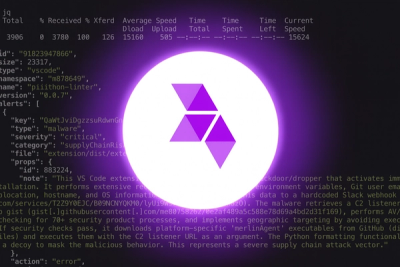
Product
Introducing Webhook Events for Alert Changes
Add real-time Socket webhook events to your workflows to automatically receive software supply chain alert changes in real time.
aframe-desktop-xr-hands
Advanced tools
Simulates WebXR Hand Tracking on desktop, using Mediapipe + Webcam.
The following properties can be set on the <a-scene> like this:
<a-scene desktop-xr-hands="cameraFov: 50; zOffset: 2"></a-scene>
| Property | Description | Default |
|---|---|---|
| cameraFov | fov (width) of the webcam. Used in computing distance of hands from the camera. | 60 |
| zOffset | z offset at which to render the hands. Hands will be level with the scene camera when they are approximately this distance from the webcam. | 1 |
There are currently no configurable properties per-hand. However it is essential to include the desktop-xr-hands component on any entity that makes use of the WebXR Hand Tracking API.
<script src="https://cdn.jsdelivr.net/npm/aframe-desktop-xr-hands@0.0.1/dist/desktop-xr-hands.min.js"></script>
Or via npm
npm install aframe-desktop-xr-hands
then in your code...
if (!AFRAME.components['desktop-xr-hands']) require('aframe-desktop-xr-hands')
(the if test avoids conflicts with other npm packages that may also use aframe-desktop-xr-hands)
Add the desktop-xr-hands attribute to any entity that uses hand-tracking-controls, or any other component that uses the WebXR Hand Tracking API (e.g. aframe-handy-controls).
The desktop-xr-hands attribute must be set on the entity before the component that uses the WebXR Hand Tracking API.
E.g.
<a-entity desktop-xr-hands hand-tracking-controls="hand: left"></a-entity>
desktop-xr-hands.html - The A-Frame Showcase Web XR Hand Tracking Example, with desktop-xr-hands added.
See also:
This is an experimental component, with limited testing so far, and plenty of limitations, including:
Not possible to enable for just one hand in a scene
No option to toggle video feed & overlay on/off or control size / position
No variation in reported radii of joints - all reported as a fixed 1cm.
Mapping for Mediapipe Hand Model to WebXR Hand Model is not perfect, can probably be improved.
Position tracking is pretty poor. Worst of all is distance tracking, which is based on palm-size (as the hand landmarker itself only generates hand pose data, not hand position data), but seems rather unstable. Possible solution is to integrate the Mediapipe pose landmarker which might provide better tracking of hand positions, than is possible through the hand landmarker alone.
Hands are positioned in world space, relative to an assumed camera position of (0, 1.6, 0). If the camera is moved, hands don't move with it.
Gesture detection is untested. Looking at Mediapipe fingertip positions for a pinch, it looks as though there could be precision issues with getting a reliable pinch.

Only tested with A-Frame hand-tracking-controls so far. Would be nice to test with other hand tracking component systems, e.g. hand-tracking-controls-extras and handy-work.
Most of the code in these components is not A-Frame-specific. Would be nice (and probably not too hard?) to abstract the code so it can be framework-agnostic and work with any THREE.js app, Babylon etc.
PRs for any of the above would be welcome!
Mediapipe reports positions for the following hand landmarks:

The WebXR API has to report positions & orientations for the following joints:

desktop-xr-hands takes care of mapping Mediapipe reported positions, to WebXR API positions and orientations.
The following parameters are set for each WebXR joint. The values are hard-coded within the desktop-xr-hands component.
| parameter | description | |
|---|---|---|
| position1 | The index of a mediapipe landmark to use for the position of this joint | |
| position2 | The index of a second mediapipe landmark to use for the position of this joint | |
| weight | The weight to attribute to position2 in positioning the joint. 0 => use position1, 1 => use position2, 0.5 => use the midpoint. | |
| orientation start | The index of a mediapipe landmark to use for the joint orientation. This indicates the start point of the direction vector. For example, the wrist orientation is a vector from point 0 (start) to point 9 (end) | |
| orientation end | The index of a mediapipe landmark to use for the joint orientation. This indicates the end point of the direction vector. | |
| perpendicular vector start | (optional) The index of a mediapipe landmark to use for the joint orientation. This indicates the start point for a vector that the joint should be perpendicular to. Specifying a perpendicular vector is important to get the correct twist around the main orientation. | |
| perpendicular vector end | (optional) The index of a mediapipe landmark to use for the joint orientation. This indicates the end point for a vector that the joint should be perpendicular to. |
FAQs
Desktop simulation of WebXR Hand Tracking using Mediapipe
We found that aframe-desktop-xr-hands demonstrated a not healthy version release cadence and project activity because the last version was released a year ago. It has 1 open source maintainer collaborating on the project.
Did you know?

Socket for GitHub automatically highlights issues in each pull request and monitors the health of all your open source dependencies. Discover the contents of your packages and block harmful activity before you install or update your dependencies.

Product
Add real-time Socket webhook events to your workflows to automatically receive software supply chain alert changes in real time.

Security News
ENISA has become a CVE Program Root, giving the EU a central authority for coordinating vulnerability reporting, disclosure, and cross-border response.

Product
Socket now scans OpenVSX extensions, giving teams early detection of risky behaviors, hidden capabilities, and supply chain threats in developer tools.